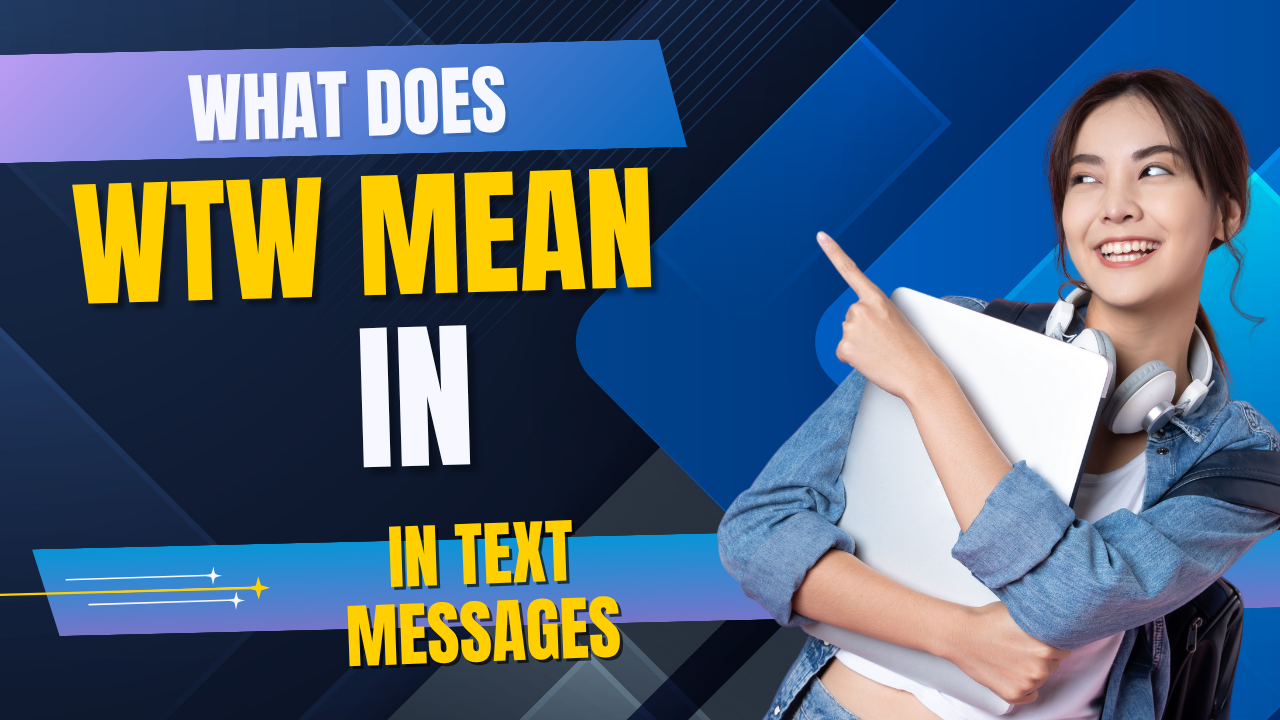In today’s fast-paced digital world, texting has become a primary form of communication, and with it comes the rise of internet slang and acronyms. From LOL to BRB, texting acronyms have revolutionized the way we communicate online. But among the sea of abbreviations, one that has gained popularity is “WTW”. If you’ve ever come across this acronym and wondered what it means, you’re not alone.
In this article, we’ll dive into the WTW meaning in detail, exploring when and how it’s used in text messages. Understanding acronyms like WTW is crucial for staying connected and communicating effectively in today’s digital conversations. So, whether you’re texting with friends or navigating online chats, knowing the meaning of WTW will help you stay on top of the latest texting trends.
Read More:What Does TLDR Mean
What Does WTW Stand For?
In the world of text messaging, WTW is a popular acronym that stands for “What’s the Word?” or “What’s the What?” It’s commonly used to ask for an update or to inquire about someone’s current situation, thoughts, or actions. Essentially, it’s a casual way of saying “What’s up?” or “What’s going on?” in a conversation.
For example:
- Person 1: “Hey! WTW with you today?”
- Person 2: “Not much, just working on some stuff. What about you?”
While “What’s the Word?” or “What’s the What?” are the most common interpretations, the meaning of WTW can sometimes change depending on the context. It might also be used in slightly different ways, such as:
- What’s the Weather? – In some cases, WTW can refer to someone asking about the current weather, especially when someone is curious about what’s happening outside.
However, “What’s the Word?” is by far the most widespread usage, and it’s the one you’ll encounter most often in casual texting.
It’s important to note that, like many acronyms, the meaning of WTW can be flexible, depending on the conversation and the relationship between the people involved.
When and How to Use WTW in Text Messages
WTW is a casual and versatile acronym that can be used in various texting scenarios. It’s typically employed when you’re looking for an update or simply checking in with someone. Below are some common situations where WTW might come in handy:
Asking for Updates on a Situation
One of the most common uses of WTW is when you want to ask someone about what’s going on or if there’s been any change in a situation. It’s a way of inquiring without directly asking, “What’s happening?” or “What’s new?”
Example Text:
- Person 1: “Hey, WTW with the project? Any progress?”
- Person 2: “Yeah, we’re almost done with the first draft. I’ll send it to you by the end of the day.”
Checking In with Friends for Their Opinion
Another scenario where WTW is useful is when you’re looking to get a friend’s opinion on something, whether it’s a decision, an event, or even a funny situation. It’s a light, conversational way to ask for someone’s thoughts.
Example Text:
- Person 1: “I’m debating whether to go to that concert tonight. WTW?”
- Person 2: “I think you should go! It’ll be a blast.”
Casually Asking What Someone Is Up To
Similar to asking “What’s up?” or “What’s going on?”, WTW is a quick way to check in with someone and see how they’re doing or what they’re currently up to.
Example Text:
- Person 1: “Hey, WTW? How’s everything going?”
- Person 2: “Just chilling at home, about to watch a movie. How about you?”
Making Small Talk or Starting a Conversation
If you’re looking to keep a conversation going or simply break the ice, WTW can be a friendly way to get the ball rolling, especially if you haven’t talked to the person in a while.
Example Text:
- Person 1: “Hey, WTW with your weekend plans?”
- Person 2: “Just heading out for a hike with some friends. What about you?”
The Popularity of WTW Among Different Groups
The popularity of WTW has grown significantly, especially among younger generations, who are more inclined to use texting acronyms for convenience and speed in their daily communication. Teenagers and young adults, in particular, frequently use WTW in casual conversations, as it fits seamlessly into their fast-paced digital interactions on platforms like Snapchat, Instagram, and group chats. Its informal nature makes it popular among friends, but it may not always be as commonly used in professional or formal settings. The ease of use and quick expression that WTW provides is one of the reasons why it has become a staple in the texting lexicon, especially among those who are active on social media and messaging apps.
Other Common Texting Acronyms and Slang
Texting acronyms have become an essential part of digital communication, helping people express emotions, reactions, and ideas quickly. Here are some of the most popular texting acronyms used in everyday conversations:
LOL – Laugh Out Loud
- Meaning: This is one of the most widely recognized texting acronyms, used to express laughter or amusement.
- Example: “That joke was hilarious, LOL!”
- Usage: It’s used to convey that something is funny or amusing, often after a joke or a humorous comment.
BRB – Be Right Back
- Meaning: This is used when you’re stepping away from a conversation but plan to return shortly.
- Example: “BRB, I need to grab a snack.”
- Usage: Commonly used in instant messaging or during online chats to let the other person know you’ll be gone briefly.
SMH – Shaking My Head
- Meaning: This acronym is used to express disbelief, disappointment, or frustration, often when something ridiculous or annoying happens.
- Example: “He really did that? SMH.”
- Usage: Used to react to something that seems foolish or frustrating, signaling a sense of exasperation or incredulity.
These acronyms help streamline communication, making it quicker and more efficient. Whether you’re laughing at something funny (LOL), stepping away briefly (BRB), or reacting to something unbelievable (SMH), these common texting abbreviations have become integral parts of casual digital conversations.
Other Possible Meanings of WTW
While WTW is most commonly understood as “What’s the Word?” or “What’s the What?” in text messaging, it can have different meanings depending on the context. Here are a few alternative interpretations of WTW:
What’s the Weather?
- Meaning: In some cases, WTW may be used to ask about the current weather, especially if the conversation is about plans or outdoor activities.
- Example: “Planning a trip today, WTW in your area?”
- Usage: This is more common in casual conversations where weather is relevant to the discussion.
What’s the Word on the Street?
- Meaning: This variation of WTW is used when asking about the latest news, gossip, or updates on a specific topic or event.
- Example: “Hey, WTW about the new movie release?”
- Usage: Often used when looking for the latest buzz or public opinion on a current event.
Walk Through Walls
- Meaning: In more specialized contexts like gaming or tech, WTW could stand for “Walk Through Walls,” a cheat code or feature in video games that allows players to pass through physical barriers.
- Example: “I activated the WTW cheat and now I can move through obstacles.”
- Usage: Common in gaming circles or discussions about gaming cheats and tricks.
While these meanings are less common, they demonstrate how WTW can be flexible and take on different interpretations depending on the situation. Always consider the context of the conversation to understand the intended meaning.
The Evolution of Texting Slang
Texting acronyms, such as WTW, have become an essential part of modern communication, primarily because they save time and effort in our fast-paced, digital world. In a space where brevity is key, acronyms allow people to convey complex messages in a few short characters, making it easier and quicker to get ideas across. Whether you’re sending a quick message to check in with a friend or asking for an update, abbreviations like WTW reduce the need for typing out longer phrases, making conversations more efficient and fluid.
The rise of social media platforms and instant messaging apps has significantly influenced the evolution of language. As these platforms encourage rapid, informal communication, new slang terms and abbreviations have emerged to keep up with the fast nature of digital interactions. Social media users, especially on platforms like Twitter, Instagram, and Snapchat, have embraced acronyms because they fit well with character limits and the expectation for quick, punchy communication. As a result, acronyms like LOL, BRB, and WTW have become commonplace, evolving alongside texting culture.
Acronyms are particularly popular among younger generations, such as teenagers and young adults, who are more immersed in digital communication. They’ve grown up in an era where texting and social media have shaped how they express themselves.
For them, using acronyms like WTW is second nature, as these shorthand expressions make it easier to stay connected while navigating their busy lives. Moreover, using acronyms often creates a sense of belonging to a particular group or community, further cementing their popularity in youth culture.
WTW Across Social Media Platforms
While primarily used in text messaging, WTW has also found its place across various social platforms:
- Snapchat: Frequently used to start a conversation or arrange impromptu meetups.
- Instagram DMs: Used for catching up, flirting, or responding to a story.
- TikTok: Generally used more in captions or comments referring to plans or relationships.
- Twitter: Often tweeted as a general question to followers to see what everyone is doing at the moment.
Despite the platform, the general meaning of WTW remains consistent across the digital world: it’s a
Is It Appropriate to Use WTW in Formal Communication?
In formal communication, such as professional emails or business meetings, it’s best to avoid using texting acronyms like WTW. Formal settings require clear, precise language, and acronyms may come across as unprofessional or overly casual. Stick to full sentences to maintain a tone of professionalism and respect.
Tips for Using Texting Acronyms Effectively
Here are a few simple tips for using WTW properly in text conversations:
- Know your audience: Avoid using WTW in formal or professional contexts.
- Use it to initiate or maintain conversation: WTW works well for casual check-ins or planning hangouts.
- Respond appropriately: If someone texts you “WTW,” it’s an invitation to share what you’re up to and potentially start a conversation or make plans.
Conclusion
In conclusion, understanding WTW and other texting acronyms is essential for staying connected in today’s digital communication landscape. Whether you’re asking for updates, checking in with friends, or simply engaging in casual conversation, WTW offers a quick and efficient way to communicate. However, it’s important to use it appropriately, recognizing that texting acronyms are best suited for informal settings. By mastering acronyms like WTW, you can keep your conversations both efficient and modern while staying in tune with the evolving language of texting.
Frequently Asked Questions
What does WTW mean in text messages?
WTW stands for “What’s the Word?” or “What’s the What?” and is used in text messages to ask for updates or check in with someone in a casual, informal way.
Can I use WTW in formal communication?
It’s best to avoid using WTW in formal settings like business emails or professional conversations, as texting acronyms are generally too casual for such contexts.
Are there other meanings for WTW?
Yes, WTW can also mean “What’s the Weather?” or “What’s the Word on the Street?” depending on the context of the conversation.
How is WTW used in text messages?
You can use WTW when asking for updates, checking in with someone, or casually starting a conversation, like: “Hey, WTW with your plans for tonight?”
Is WTW only used by younger people?
While WTW is especially popular among younger generations, texting acronyms are used across all age groups, though their usage is more common in casual and social settings.

